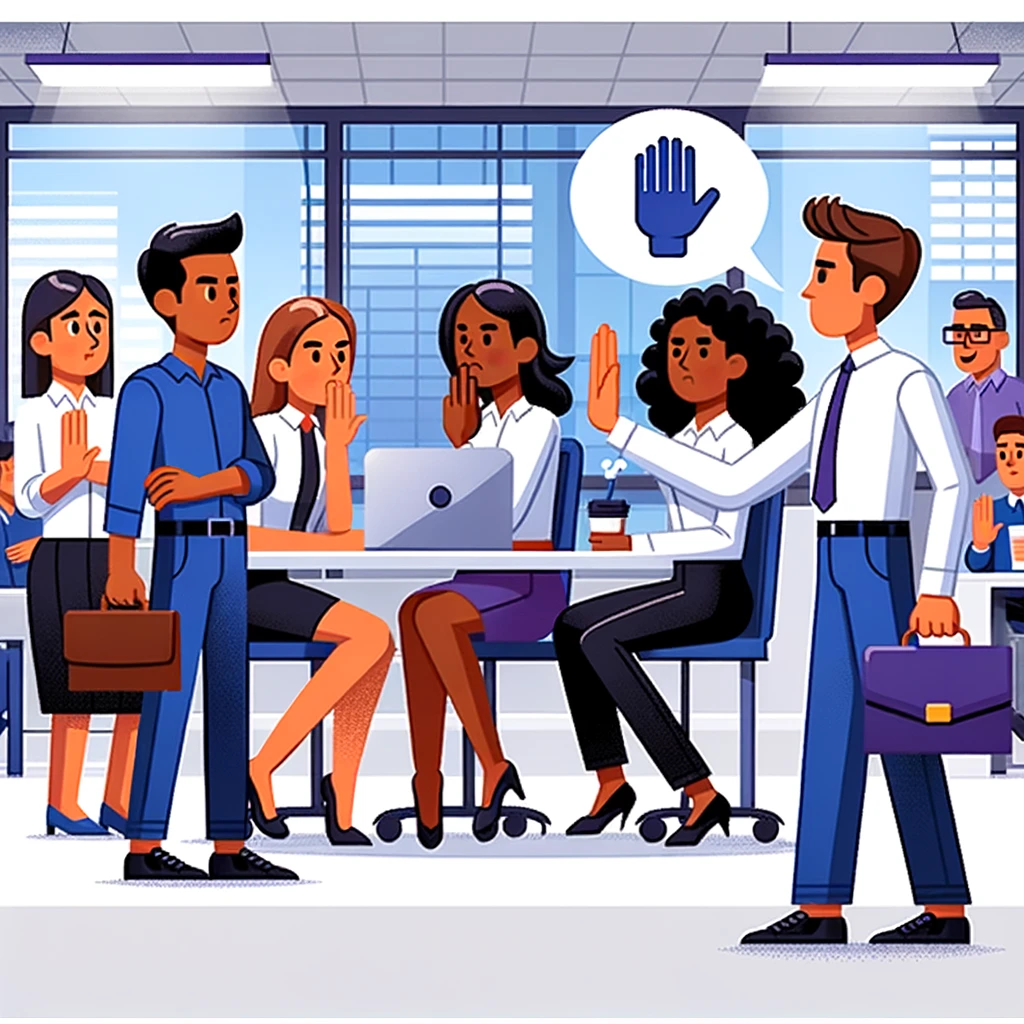Estimated reading time: 10 mins
Learning how to deal with difficult coworkers is a challenge that, like many of you, I’ve faced time and again in my career. It’s an almost inevitable part of any professional environment. Whether it’s the team member who always finds something to complain about, the one who refuses to cooperate, or the one who seems to thrive on conflict, these personalities can make your work life less enjoyable and, at times, utterly frustrating. But over the years, through trial and error, and a fair bit of patience, I’ve developed a strategy that has not only helped me manage these relationships but also turned some of them into positive experiences.

In my journey, I’ve learned that dealing with difficult coworkers isn’t just about handling them; it’s about understanding them and, importantly, understanding yourself in the process. It’s about learning how to communicate effectively, set boundaries, and find common ground, even when it seems impossible. And sometimes, it’s about knowing when to escalate the issue to someone else.
I want to share with you a five-step approach that I’ve personally used and refined over the years. This approach has been a game-changer for me, transforming stressful interactions into manageable ones, and in some cases, even rewarding ones. I wish I had been taught how to deal with difficult coworkers in my early career! So it gives me pleasure to share my experiences, and perhaps, save you many headaches.
Whether you’re struggling with a challenging colleague right now or want to be prepared for future encounters, these steps can offer you a framework to navigate these tricky waters. My hope is that by sharing my experience, you’ll find the tools and confidence to know how to deal with difficult coworkers in a way that preserves your peace of mind and professional integrity.
Step 1: Reflect and Understand
When faced with a difficult coworker, the first thing I learned to do was to pause and reflect. (This was one of the most difficult things for my to do when learning how to deal with difficult coworkers!) It’s easy to react immediately or take things personally, but I found that understanding their perspective can change everything. I would ask myself questions like, “What might be driving their behavior?” or “Is there something in their personal or professional life that’s affecting them?” This step isn’t about justifying their actions, but about gaining a deeper insight into what might be behind their difficult behavior.


I remember dealing with a colleague who was constantly dismissive of others’ ideas. Initially, I felt they were just arrogant. But upon reflection, I considered other factors. Maybe they felt insecure about their own position or were under pressure I wasn’t aware of. This shift in perspective helped me approach the situation more empathetically.
Empathy doesn’t mean excusing negative behavior; it means understanding the human behind the behavior. This understanding can be a powerful tool when becoming an expert at how to deal with difficult coworkers. It allows you to detach from the immediate emotional response and think more strategically about how to address the issue. It also prepares you for a more constructive conversation when you do decide to engage with them.
Furthermore, this reflection phase helped me understand my own reactions. Why was I reacting the way I did? Was it something in their tone, words, or actions that triggered a specific response from me? Understanding my own triggers helped me stay calm and composed in dealing with the situation.
In summary, this first step of reflection and understanding was about putting myself in their shoes, as well as being aware of my own emotions and reactions. It set the foundation for a more thoughtful and effective approach to handling difficult coworkers.
Step 2: Establish Boundaries


Establishing boundaries is a critical step in dealing with difficult coworkers, one that I learned through some tough experiences. Initially, I struggled with this, often feeling guilty or confrontational. But I realized that learning how to deal with difficult coworkers involved setting boundaries, which is not just important for my well-being; it’s essential for maintaining a professional and productive work environment.
To begin, I identified what behaviors I found disruptive or unacceptable. For instance, a coworker who constantly interrupted my work with their problems was affecting my focus and productivity. Recognizing this allowed me to understand where I needed to draw the line.
The next step was to communicate these boundaries assertively but respectfully. I remember the first time I had to do this. I said, “I understand you need support, but I need to concentrate on my tasks right now. Can we discuss this later?” This approach was direct but polite. It communicated my needs without being dismissive of theirs.
It’s also important to be consistent with these boundaries. Initially, people might continue their old behaviors, testing your limits either consciously or unconsciously. Consistency shows that you’re serious about your boundaries. Over time, I noticed a change in my coworker’s behavior. They began respecting my space and time.
Another aspect of establishing boundaries is being prepared for pushback. Not everyone responds positively at first. In these cases, I remained firm yet calm, reiterating my boundaries. I found that being clear about the impact of their behavior helped. I’d say something like, “When you do X, it makes it hard for me to do Y.” This helped in making the conversation about the work, not the person.
In summary, establishing boundaries involves identifying disruptive behaviors, communicating your limits assertively yet respectfully, being consistent, and preparing for pushback. It’s a process that requires patience and perseverance, but it’s crucial for a healthy work environment.
Step 3: Open a Dialogue
Opening a dialogue is perhaps one of the most crucial parts of learning how to deal with difficult coworkers. This step took me some time to master, but it’s been invaluable. Here’s how I approached it:
First, I chose the right time and place. Timing is everything. I avoided moments when tensions were high. Instead, I opted for a neutral time, preferably in a private setting where we wouldn’t be interrupted or feel embarrassed in front of others.
I started the conversation with a positive or neutral tone. My opening line would often be something like, “Do you have a moment? I’d like to discuss something that I think will improve our collaboration.” This set a constructive tone right from the start.
I focused on “I” statements to express how I felt about certain behaviors without accusing them. For instance, “I feel overwhelmed when I am given short notice for project changes,” rather than “You never give me enough time for projects.” This way, I expressed my perspective without triggering defensiveness.
Active listening played a huge role. When they spoke, I really listened, not just to respond but to understand. This often meant putting aside my own feelings temporarily and acknowledging their viewpoint. I found that this often encouraged them to do the same for me.
I also came prepared with specific examples. This wasn’t to point fingers but to provide clear context. “Last Tuesday, when the project deadline was suddenly moved up, I found it challenging to…” was a better approach than vague statements.
Lastly, I suggested solutions or compromises. “How about we have a quick check-in each morning to align our priorities?” This showed I was willing to work together towards a better working relationship.
By following these steps, I turned many confrontations into constructive conversations. It didn’t work every time, but it certainly opened the door to better understanding and cooperation more often than not.
Step 4: Find Common Ground


Finding common ground with a difficult coworker can feel like searching for a needle in a haystack, but it’s often more achievable than you might think. This step was a game-changer for me. It’s about identifying shared interests, goals, or values that can serve as a foundation for a more positive interaction. Once you know how to deal with difficult coworkers as an expert, this is something you will tend to do early on.
But at first, I was skeptical. How could I find common ground with someone who seemed so different from me? But then, I started paying attention to small details. I listened for mentions of hobbies, weekend activities, or work goals during casual conversations. Sometimes, the common ground was as simple as both of us being frustrated by a particular software we had to use, or both enjoying a particular type of cuisine.
Once I identified a potential area of commonality, I used it as a conversation starter. For instance, when I found out a challenging coworker was also a parent, I initiated conversations about schools and parenting challenges. These discussions didn’t erase the difficulties we had, but they humanized us to each other. We were no longer just ‘difficult coworkers’ but people with similar experiences and struggles.
Building on these small connections didn’t change our entire working relationship overnight, but it gradually improved how we interacted. We started seeing each other as teammates working towards similar goals, rather than adversaries. It’s amazing how finding even the smallest common ground can break down barriers and open up lines of communication.
Remember, the goal here is not to become best friends, but to create a more amicable and cooperative working environment. You might be surprised at how effective this step can be in turning a difficult relationship into a manageable, and sometimes even enjoyable, one.
Step 5: Know When to Seek Help
Recognizing when to seek help has been one of the most important lessons in my journey of dealing with difficult coworkers. There comes a point where an issue may escalate beyond what can be managed through personal efforts. This step is about understanding that sometimes, professional intervention is necessary for resolution and well-being.
In my experience, the time to seek help is when the situation starts affecting your mental health, work performance, or if the behavior of the coworker crosses into harassment or bullying. Initially, I was hesitant to involve others. I worried about being perceived as incapable of handling my own problems. But I realized that reaching out was not a sign of weakness; it was a smart, strategic move.
Involving a supervisor or HR should be done with care and professionalism. When I reached this point, I prepared for the conversation. I gathered evidence of the difficult interactions, ensuring I had specific examples and dates. This wasn’t to ‘build a case’ against my coworker, but to provide a clear, factual account of what was happening.
During the meeting, I focused on how the situation was impacting my work and well-being. I avoided making it personal against the coworker. My goal was to find a solution, not to place blame.
Remember, HR and supervisors are there to maintain a healthy work environment. Their role is to address such issues and ensure that all employees can work effectively and without undue stress. Trust in their ability to handle the situation and know that seeking help is a step towards a more positive work environment for everyone.


Ultimately, this step is about recognizing the limits of what you can handle alone and understanding the value of the resources and support systems available in your workplace.
This was my Experience of how to Deal with Difficult Coworkers…
This is what worked for me. Reflect and understand, establish boundaries, open a dialogue, find common ground, and know when to seek help. Each step builds on the last, helping you navigate the tricky waters of dealing with difficult coworkers. Remember, you’re not alone in this. We all face these challenges, and with the right approach, you can overcome them. Learning how to deal with difficult coworkers might be tough, at first, but in the end its much better to deal with the situation rather than let the difficulties persist.
